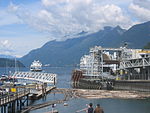The North Shore Mountains are a mountain range overlooking Vancouver in British Columbia, Canada. Their southernmost peaks are visible from most areas in Vancouver and form a distinctive backdrop for the city.
The steep southern slopes of the North Shore Mountains limit the extent to which the municipalities of Metro Vancouver's North Shore (West Vancouver, the District of North Vancouver, the City of North Vancouver and the Village of Lions Bay) can grow. In many places on the North Shore, residential neighbourhoods abruptly end and rugged forested slopes begin. These forested slopes are crisscrossed by a large network of trails including the Baden-Powell Trail, the Howe Sound Crest Trail, the Binkert/Lions Trail and a wide variety of mountain biking trails.The North Shore Mountains are a small subrange of the Pacific Ranges, the southernmost grouping of the vast Coast Mountains. They are bounded on the south by Burrard Inlet, on the west and north-west by Howe Sound, and on the north and north-east by the Garibaldi Ranges. To the east the bounds are defined by Indian Arm (a branch of Burrard Inlet). The ridge running north from Mount Seymour has its own name, the Fannin Range, while much of the Howe Sound-flanking portion of it is known as the Britannia Range. There is debate whether the Britannia Range is part of the North Shore Mountains as there are no official boundaries of the North Shore Mountains.
Although not particularly high, these mountains are rugged and should not be underestimated. Severe weather conditions in the North Shore Mountains often contrast dramatically with mild conditions in nearby Vancouver. This is especially true in winter, but even in summer, large precipices are hidden very close to popular hiking trails and it is very easy to get lost, despite being in sight of the city. Those who venture into the North Shore Mountains for whatever reason should be well prepared at any time of year.Three deep river valleys divide the North Shore Mountains. These are, in order from west to east:
Capilano River valley
Lynn Headwaters
Lynn Valley
Lynn Canyon - known for Lynn Canyon Suspension bridge
Seymour River valleyThe Capilano and Seymour rivers emanate from the massive Metro Vancouver watershed area administered by Metro Vancouver. The watershed extends deep into the North Shore Mountains region, but is strictly off-limits to all unauthorized human activities. The Lynn Headwaters, a deep cirque valley drained by Lynn Creek, is a very popular regional park administered by Metro Vancouver.
There are two provincial parks in the area, Cypress Provincial Park and Mount Seymour Provincial Park. Both feature reliable road access, downhill ski areas, and extensive trail networks. Nearby Grouse Mountain features a downhill ski area and tourist attractions which are accessible by the Skyride, an aerial tramway. A very popular hiking trail, the Grouse Grind, climbs up the steep flanks of Grouse Mountain from the tramway parking lot. Before the Grouse Mountain Skyride was built, a chairlift operated from Skyline Drive at the head of North Vancouver's Lonsdale Avenue, and the ski area itself could be accessed via Mountain Highway, which now has a gate at its upper end in the Lynn Valley neighbourhood.
In the Seymour River valley, the Lower Seymour Conservation Reserve features over 100 km of trails including a paved bicycle path called the Seymour Valley Trailway that winds into the mountains for 10 km to Seymour Lake. It is frequently used for recreation, and occasionally for TV and film productions such as Stargate SG-1.








